Orontid Dynasty › Freyja › Tigranes the Great » Origins and History
Articles and Definitions › Contents
- Orontid Dynasty › Origins
- Freyja › Who Was
- Tigranes the Great › Who Was
Ancient civilizations › Historical places, and their characters
Orontid Dynasty › Origins
Definition and Origins
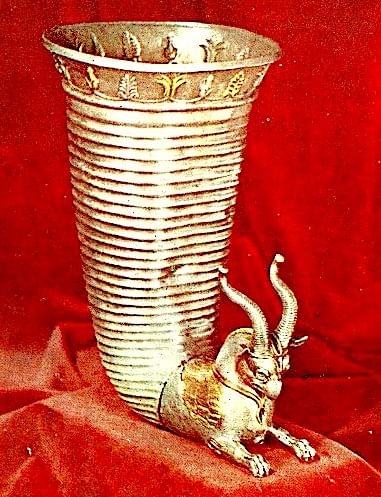
The Orontid dynasty (aka Eruandid or Yervanduni) succeeded the Kingdom of Urartu in ancient Armenia and ruled from the 6th to 3rd century BCE. Initially, the Orontids ruled as Persian satraps and the culture, language and political practices of that state were introduced into ancient Armenia. Then, under Seleucid rule, the Orontid kings became more independent and minted their own coinage. The dynasty ended around 200 BCE with the murder of Orontes IV and the appointment of king Artaxias I by the Seleucid king Antiochus III.
THE FALL OF URARTU
The founder of the royal dynasty of the Orontids was Orontes (Yervand) Sakavakyats (c. 570-560 BCE, although reign dates for most of the Orontids are disputed) who took advantage of the power vacuum caused by the collapse of the Urartu civilization in the last decade of the 6th century BCE. Urartu was a confederation of kingdoms which had ruled over ancient Armenia, eastern Turkey, and western Iran since the 9th century BCE. Its cities were attacked and destroyed over a decade or so by various peoples, notably the Scythians. The former territory of Urartu was then taken over by the Medes from c. 585 BCE and then incorporated into the Achaemenid Empire of Cyrus the Great (rc 550-530 BCE) in the mid-6th century BCE.The Achaemenians divided their new territory into two parts, and it was in the eastern province that the Orontid dynasty, known locally as the Yervand (from the Iranian word arvand, meaning “mighty”), ruled as satraps on behalf of their Persian overlords.
The old Urartian capital of Van, near the lake of the same name, was also the first capital of the Orontids. Orontes and his successors ruled over a disparate population of various ethnic groups, as here explained by the historian RG Hovannisian:
The Armenian plateau at the time of its conquest by the Achaemenian kings of Iran in the second half of the 6th century BC was inhabited by a mixture of peoples, probably with a predominance of Urarteans and Armenians, whose appellations were used interchangeably at Behistun to identify the country. It is likely, though, that the Armenian-speakers developed the strongest dynastic and cultural ties to the Iranians, becoming thereby the dominant population to which the other ethnic groups were gradually assimilated…But it would seem that some greater diversity persisted on the plateau. A few tantalising monuments, in addition to persistent proper names, may indicate that Hittite and ancient Semitic culture survived. (34)
PERSIA & THE ORONTID SATRAPS
The Orontids soon became ambitious to rule entirely free from Persian oversight and while the Achaemenids were distracted by the succession of Darius I (r. 522-486 BCE) they seceded from the Empire in 522 BCE. Naturally, the Persians were not best pleased at these developments and so set about reconquering the province, which was accomplished within a year, albeit taking five battles to restore order. It is then that we have the first known mention of the Persian client state of Armena or Armenia. Recorded in a c. 520 BCE inscription of Darius on a rock face in Behistun, Persia, it lists the king's royal possessions in Old Persian.
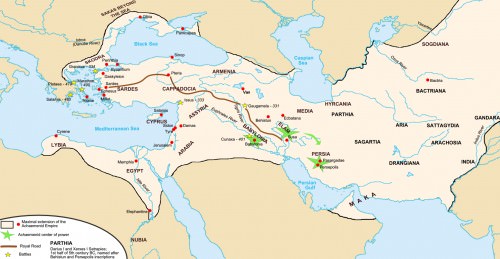
Achaemenid Empire Map
The Royal Highway connected southern Armenia to the Persian capitals of Susa and Persepolis and ran on westwards to Sardis in Asia Minor. The province of Armena was a valued source of horses and pack animals with the annual tribute consisting of some 20,000 colts along with the more convertible 400 talents of silver. Men and weapons were another form of tribute and Armenians fought in Persian campaigns as far as Greece and Egypt.
This period of the region's history is, unfortunately, lacking detailed sources and information - the inscriptions of Assyria and Babylonia, so useful for our knowledge of the Urartu civilization, now fall silent, as does archaeology, and there begins what RG Hovannisian describes as “a long period of darkness” (38). However, certain conclusions can be tentatively drawn from those facts we do know, as here explained by RP Adalian:
Few records of this period of Armenian history survive. This very scarcity is the evidence of a style of government that relied on tradition and conventions that did not require announcement and amplification. In this respect, it was a period of little innovation and possibly of considerable stability. The Persian Empire effectively protected Armenia from external conflict. Moreover, the level of tribute extracted appears to have been tolerable, for the country continued on a course of economic development, which may have lacked the intensity of the Urartian management, but whose progress was measurable by the sizeable contingents the Armenians provided the imperial army. (14)
BY THE 4TH CENTURY BCE, THE TWO DIVIDED REGIONS UNDER PERSIAN CONTROL HAD BEEN POLITICALLY MERGED, THEIR POPULATIONS HAD MIXED & THE LANGUAGE HAD BECOME ONE: ARMENIAN.
In 401 BCE the Greek general Xenophon marched through Armenia on his way to Mesopotamia. Xenophon then records in his Anabasis that the land abounds in agricultural produce and the then Orontid ruler of Armenia was the son-in-law of the Persian king Artaxerxes I (r. 464-424 BCE), illustrating the close relations between the two regions in terms of culture (eg official language, Zoroastrian religion, crafts and clothing), politics, and dynastic families. By the mid-4th century BCE, the two divided regions under Persian control had been politically merged, their populations had mixed, and the language had become one: Armenian.
THE MACEDONIANS
At the 333 BCE Battle of Issus between Alexander the Great and Darius III, an Armenian contingent of 40,000 infantry and 7,000 cavalry fought on the losing side of Persia. Under their king Yervand, the Armenians would also support Persia in the Battle of Gaugamela two years later, but with the same final outcome as the Persians were unable to stop Alexander ’s relentless march eastwards. Armenia was then formally annexed by Macedon, and in 330 BCE Armavir was made the capital (the former Urartian city of Argishtihinili). It seems likely that the political rule of Armenia remained much as under the Persians, though, with the Orontids ruling as semi-independent kings within the now vast Macedonian Empire. Indeed, even the Armenian rulers struggled to control the powerful local lords, known as nacharars and forming a hereditary nobility, such was the “feudal” nature of the region at this time.
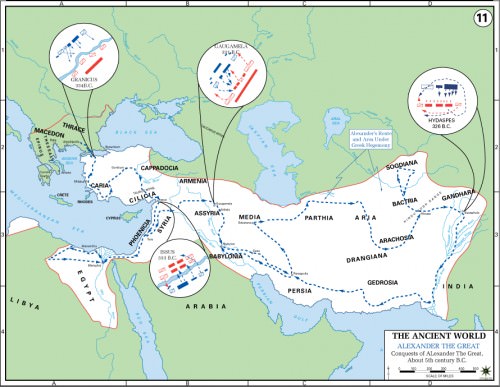
Map of Alexander the Great's Conquests
THE SELEUCID EMPIRE
From 321 BCE the Seleucids governed the Asian portion of Alexander's empire after the young leader's death, leading to a certain Hellenization which created a rich cultural mix of Armenian, Persian, and Greek elements. Such was the size of the Seleucid Empire that the Orontid rulers were left to enjoy a good deal of autonomy in what was now a region with three distinct areas: Lesser Armenia (to the northwest, near the Black Sea), Greater Armenia (the traditional heartland of the Armenian people) and Sophene (aka Dsopk, in the southwest).
Around 260 BCE the newly unified kingdom of Commagene and Sophene arose in western Armenia, governed by Sames (aka Samos ), a ruler of Orontid descent. It was Sames (rc 260-240 BCE) who founded the important city of Samosata (Shamshat).The period also saw the resurgence of the Persians and the growth of the Parthian Empire (247 BCE - 224 CE), who claimed sovereignty over Armenia. Sames' successor was Arsames (Arsham), who founded Arsamosata (Arshamshat) and Arsameia, both on the Nymphaios River. His independence from the Seleucid Empire is illustrated by the minting of coinage in his own name and awarding himself the title of king. The Orontids were finally catching up with the progress made in the surrounding states after decades of exposure to Greek cultural ideas, which included language, coinage, and new cities with vibrant economies which carried the name of their founders.
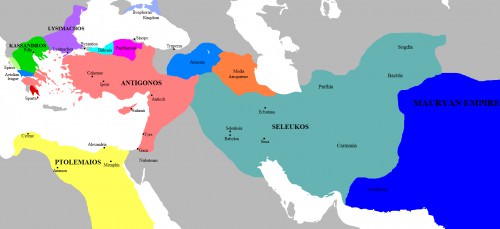
Map of the Successor Kingdoms, c. 303 BCE
Armenia still, though, remained under nominal Seleucid control with the Orontids continuing as the vassal's ruling dynasty.Horses continued to be a valuable asset, Antiochus III (r. 222-187 BCE) notably reinforcing the tribute system which seems to have lapsed and extracting both 300 talents of silver and 1,000 of the animals for his armies as they passed through the region on their way to suppress the Parthians.
DEMISE
The last of the Orontid dynasty to rule in eastern Armenia was King Orontes IV (to the Armenians, Yervand IV or Yervand the Last, rc 212-200 BCE). Yervand, another ruler who gave himself the title of king, moved the capital from Armavir to the newly founded Yervandashat, meaning “Yervand's Joy”. Yervand IV's successor, following the king's murder, was the founder of the next dynasty to dominate Armenia in the coming centuries, King Artaxias I (Artashes). Artaxias, significantly, was backed and made a direct satrap by Antiochus III, probably in a move to reduce Armenian independence from Seleucid overrule. The Artaxiad dynasty (aka Artashesian dynasty), with its capital at Artaxata (Artashat) would throw off Seleucid suzerainty and rule Armenia until the first decade of the 1st century CE.
This article was made possible with generous support from the National Association for Armenian Studies and Researchand the Knights of Vartan Fund for Armenian Studies.
Freyja › Origins
Definition and Origins

Freyja (Old Norse for 'Lady', 'Woman', or 'Mistress') is the best-known and most important goddess in Norse mythology.Beautiful and many-functioned, she features heavily as a fertility goddess stemming from her place in the Vanir family of the gods (the other and main one is the Æsir family) along with her twin brother Freyr and father Njord, and stars in many myths recorded in Old Norse literature as lover or object of lust. She lives in Fólkvangr ('Field of the People'), rides a carriage drawn by cats, and is connected not just with love and lust but also with wealth, magic, as well as hand-picking half of all fallen warriors on battlefields to go into Odin 's hall of Valhalla – the other half being selected by Odin himself. She likely played an important role in old Scandinavian religion.
FAMILY
Freyja is part of the Vanir family of the gods who handle all things fertility-related, including harvests (her brother Freyr); wind, sea, and wealth (her father Njord); and her own expertise regarding love, lust, and wealth, too. Her mother appears to have been giant-daughter and wife of Njord, Skadi, and while originally Freyja may have been paired in a brother-sister married couple with Freyr, Icelandic mythographer Snorri Sturluson (1179-1241 CE) – our most comprehensive source when it comes to Norse mythology – has her down as wife of Ódr, who she has two daughters with; Hnoss and Gersimi ( Gylfaginning, 35).These names both mean something along the lines of 'preciousness' or 'treasure' and were possibly used in later poetry as manifestations of Freyja herself.
Ódr is said to have gone traipsing around on long journeys, inexplicably leaving Freyja behind, who would then search for him while weeping golden tears; this tale dates back to at least as early as the 10th century CE. He and Odin are commonly thought to have originally been one and the same person, with Ódr functioning as a shortened form of Odin.
THE BASELINE OF FREYJA'S VARIOUS FUNCTIONS COMES FROM HER BEING A FERTILITY GODDESS, WITH THE HANDED-DOWN MYTHOLOGY EMPHASISING HER ROLE IN ALL THINGS RELATED TO SEXUALITY.
ATTRIBUTES
One of Freyja's attributes has already been mentioned: her cat-drawn carriage with which she zooms around the Norse mythological cosmos. Another is a garment - a coat, cloak or dress-like thing - made out of falcon feathers. Possibly, the boar Hildisvíni should also be counted among Freyja's attributes; the Hyndluljóð poem has her riding said boar, and a boar connection, in general, is made more plausible by the fact that her brother Freyr is also associated with a boar, in his case named Gullinborsti. Sýr, another name of Freyja's, is sometimes translated as 'sow', too, but it also might mean 'to protect', 'to shield,' in which case it would negate this third boar link. Germanic mythological powerhouse HR Ellis Davidson adds another animal: "Horses were certainly associated with the fertility pair Freyr and Freyja, and said to be kept in their holy places" (104).Her last - but not least - attribute is the necklace Brísingamen.
FREYJA'S MANY ROLES
The baseline of Freyja's various functions comes from her role as fertility goddess as per her Vanir descent. Specifically, her other name Horn (Hǫrn, or Härn) probably comes from Old Norse horr, which means flax or linen. This was an important product which began being cultivated early on in Scandinavia and was thought to ward off evil and give fertility to humankind.Flax manufacture was a female affair, and as bridal dresses were made of linen, Freyja became a sort of defender of love and weddings, too. Another one of her names, Gefn, is Old Norse for 'giver', bringing to mind a role as a goddess of plenty.

Freyja With Carriage
The handed-down mythology emphasises Freyja's role in all things related to sexuality (apart from childbirth, with which she seems unconcerned). For one, she often features as an irresistible object of lust, mainly in the eyes of the giants. The giant Thrym, for example, is only cool with returning the hammer he has stolen from Thor if he gets Freyja for his own. Besides her being the 'price' of many things - which the other gods try to avoid paying, as such - other myths reinforce Freyja's supposed free and considerable sexuality. Although Loki in the Lokasenna poem badmouths everyone around him and accuses all the goddesses of various sexual acts, Freyja is reprimanded by Loki as follows:
Be silent, Freyja! › for fully I know thee,Sinless thou art not thyself;Of the gods and elves › who are gathered here,Each one as thy lover has lain. (30)
She also consents to sleep with four dwarves in turn in order for them to hand over the Brísingamen to her and is accused in the Hyndluljóð poem of being the hero Óttar's lover. Presumably, then, early Scandinavians looked to Freyja in matters of love and lust.
To make things even better, Freyja is also a goddess of wealth, as attested to by the many poetic references that link her to treasure. Her tears are said to be made of gold, even being synonymous with the material:
Gold is called Freyja's Tears (…). So sang Skúli Thorsteinsson:Many a fearless swordsmanReceived the Tears of Freyja.( Skáldskaparmál, 37)
The fact that Freyja's daughters' names Hnoss and Gersimi mean 'preciousness' or 'treasure' could arguably be seen as the "product of poetic convention in which Freyja was recognized as the source of treasure: perhaps as the weeper of golden tears, perhaps as a goddess ruling over wealth" (Billington & Green, 61).

Thor Disguised as Freyja
Her connection with magic is also well-known, and Snorri Sturluson relays how it was Freyja who first taught the shamanistic magic called seiðr to the Æsir. Finally, the way Freyja chooses slain warriors to be on her as opposed to Odin's team carries her into more ferocious spheres, functioning as a goddess of death and perhaps even battle itself. Which god selects you seems to boil down to social or personal status, or perhaps comes from the fact that both the Vanir and the Æsir needed someone to fulfil this role on the battlefield. This link between Freyja and Odin, as well as Odin's own strong proficiency with magic, helps illustrate how Odin and Ódr, Freyja's husband, could plausibly have originally been the same person.
MYTHS INVOLVING FREYJA
As evidenced above, there are plenty of myths recorded in the Old Norse sources that are keen to dive into the subject of Freyja. The Hyndluljóð poem emphasises she was more than just a pretty face; in it, Freyja visits wise-woman Hyndla asking her to unravel the hero Óttar's ancestry, soaking up this knowledge. However, in the Þrymskviða (the ' Lay of Thrym ', a poem possibly composed in the 12th or 13th century CE and found in the Poetic Edda ), her desirability is once again a core theme.The story tells of Thor's hammer being stolen by the giant Thrym, who will not return the hammer unless he gets his hands on Freyja. Freyja refuses to tag along, however, giving up the Brísingamen to help Thor disguise himself as her. After almost giving things away because Thor gorged himself to such an extent at the wedding banquet so as to raise suspicion - his burning eyes not helping either - Loki luckily smooth-talks his way out of it and ensures they get the hammer back. For good measure, Thor kills Thrym and a bunch of other giants on his way out.

Freyja Amulet
As for other giant-related myths, the giant Hrungnir boasts he would bodily move Valhalla into Jotunheimen (the realm of the giants), sink Asgard (the realm of the gods), and kill all the gods except for Freyja and Sif, who he will take home with him ( Skáldskaparmál, 17). In the tale of the Giant Master Builder, a giant offers to build walls around Asgard as long as he gets Freyja, the sun and the moon. Regarding her necklace Brísingamen, which is assigned to Freyja by Late Old Norse sources (13th and 14th centuries CE), the most famous myth concerns its theft (most commonly by Loki) but is preserved in such a fragmentary and tricky way that it is now rather hard to come up with one comprehensive story. The most detailed version is also the youngest and thus not the pinnacle of reliability: the Sǫrla Þáttr, which survives in the 14th century CE Flateyjarbók, describes how Freyja sleeps with four dwarves to get the Brísingamen, and how Odin then forces Loki to steal the necklace from her. Loki enters her bedroom as a fly, stings her so she moves her hand off of the necklace, and grabs it. By contrast, Snorri Sturluson has Loki and Heimdall fighting each other over the necklace ( Skáldskaparmál, 8).
CULT OF FREYJA
As a fertility goddess, Freyja would have taken up a central role in old Scandinavian religion, playing a part in the circle of life.JP Schjødt explains her special position:
Freyja is one of the few individual goddesses who has had a major role in the more official religious cult (whereas many female deities seen as collectives played a part in both myth and ritual). She incorporates many traits that can be found in fertility goddesses all over the world, among whom is a clear connection also to death.(Brink & Price, 221)
The Old Norse sources do not specifically detail the existence of a cult of Freyja per se, but the large number of place-names in Sweden and Norway related to her name, such as Frøihov (from Freyjuhof, 'Freyja's temple ') and Frǫvi (from Freyjuvé, 'Freyja's shrine'), show clear worship, perhaps even pointing to a public cult as opposed to the domestic cult one would expect of a goddess of love. It is clear that the people of Iceland on the cusp of conversion to Christianity around the year 1000 CE still had Freyja clearly on their mind. The Íslendingabók states that Hjalti Skeggjason, a supporter of Christianity, was outlawed for blasphemy after calling Freyja a bitch (in this case a female dog, but taken to mean he wanted to call her a whore) at the Althing parliament. She was obviously still important enough for people to not successfully get away with these sorts of things.
Tigranes the Great › Origins
Definition and Origins
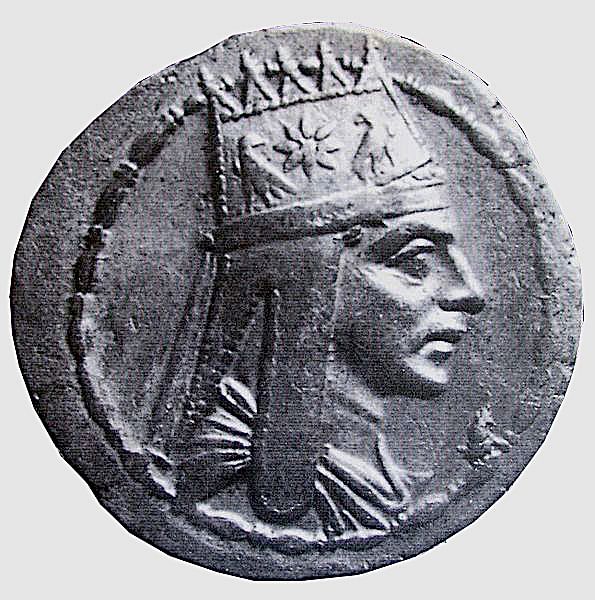
Tigranes II or Tigranes the Great ruled as the king of Armenia from c. 95 to c. 56 BCE. Expanding in all directions, at its peak, Tigranes' Armenian Empire stretched from the Black Sea to the Mediterranean. Not before or since would Armenians control such a huge swathe of Asia. Tigranes would only be checked once his kingdom became enmeshed in the ambitions of the two regional superpowers, Parthia and Rome, when his alliance with Mithridates VI, king of Pontus, proved his undoing.
THE ARTAXIAD DYNASTY
The Artaxiad (Artashesian) dynasty had replaced the Orontid dynasty and ruled ancient Armenia from c. 200 BCE to the first decade of the 1st century CE. Founded by Artaxias I (rc 200 - c. 160 BCE), the dynasty would ensure Armenia enjoyed a sustained period of prosperity and regional importance and no one would contribute more than their greatest king Tigranes II, widely considered the most important and successful ruler in Armenia's entire history.
SUCCESSION
After a rather dim period for the historical record of Armenia, a shining light suddenly arrives on the scene with a mass of documentation covering the reign of Tigranes II (aka Tigran II). There is the caveat that most sources, and all contemporary ones, are from the Romans and so they tend to be more than a little biased against one of their more serious foes in the east.Later sources help redress the balance but these can also have their problems in their sometimes obvious selection and omission of events for patriotic reasons.
FROM 85 BCE TIGRANES RATHER GRANDLY BEGAN CALLING HIMSELF THE “KING OF KINGS”.
Tigranes was put upon the throne of Armenia by the Parthians after his uncle, the Armenian king Artavasdes I, had been forced to send Tigranes as a hostage to the Parthians following his military defeat to that state. When his father Tigranes I died c. 95 BCE, Tigranes was sent back to Armenia to take his place on the throne. The new king had to cede the “Seventy Valleys” to the Parthians (a territory probably towards modern Azerbaijan) but he soon proved to be anything but a compliant client ruler.
EXPANDING THE EMPIRE
Tigranes was able to take advantage of the crumbling of the Seleucid Empire as well as the Parthians being distracted by the still chaotic aftermath of Mithridates II's death in 91 BCE and invasions on their eastern borders. The Armenian monarch could thus set about expanding his own kingdom even further. First, he annexed the other part of traditional Armenia, the kingdom of Sophene in 94 BCE. With formidable siege engines and units of heavily-armoured cavalry, he then re-took the “Seventy Valleys” and went on an extended spree of conquest from 88 to 85 BCE. He conquered Cappadocia, Adiabene, Gordyene, Media Atropatene, Phoenicia and parts of Cilicia and Syria, including Antioch. The latter city invited him to be their king and subsequently minted silver tetradrachm coins with images of Tigranes wearing his eastern tiara and, on the reverse, a woman with a turreted crown and holding the palm of victory. The Armenian king even sacked Ecbatana, the Parthian royal summer residence in 87 BCE while the Parthians were struggling to deal with invading northern nomads.

Empire of Tigranes the Great
Another policy of Tigranes', besides conquest, was to improve trade relations with certain states, notably Babylonia. Trade contacts were set up with the Skenite Arabs, through whose territory goods could be exchanged with Babylon. This was also the reason why Tigranes took no risks and installed his brother as ruler of Nisibis which controlled trade from Mesopotamia to the west.
KING OF KINGS
From 85 BCE, having acquired a decent-sized empire, Tigranes rather grandly began calling himself the “King of Kings” (Persian: shahanshah ), although the title is further evidence that he left conquered monarchs to rule as vassals. Indeed, the Greek writer Plutarch (c. 45 - c. 125 CE) famously noted that Tigranes was always followed around by an entourage of four kings who acted as his servants. This comment may well have been based on a misunderstanding and the four men in question could well have been close counsellors who were also kings of their own respective regions but served the Armenian king as viceroys. Within the empire, conquered states might have kept their political apparatus but they were still obliged to pay tribute and contribute to Tigranes' army. Further, populations were relocated to reduce dissension and increase loyalty wherever required. Tigranes' title of King of Kings was then well justified and he made sure he looked the part as the historian VM Kurkjian here summarises:
Tigranes' public appearances were spectacular. He displayed all the pomp and magnificence becoming to a successor of Darius or Xerxes. Theoretically an equal of the gods, he clothed himself in a tunic striped in white and purple, and a mantle entirely purple. He always wore everywhere (even when hunting) a tiara of precious stones. Four of his vassal kings stood about his throne, and when he rode forth on horseback, they ran on foot before and beside him. (64)
THE CAPITAL TIGRANOCERTA HAD SUCH AMENITIES AS A GREEK THEATRE, HUNTING PARKS & PLEASURE GARDENS.
Tigranes was noted as an admirer of Greek culture and the capital city he founded in 83 BCE, Tigranocerta (aka Tigranakert, meaning “Tigranes' foundation” but of uncertain location), was famously Hellenistic in its architecture. The city had impressive fortifications with the walls reaching a height of 22 metres and incorporating stables, such was their thickness. There were also such amenities as a Greek theatre, hunting parks and pleasure gardens. Tigranes was said to have forcibly relocated (a traditional figure of) 300,000 people to the new city, most of them from Cappadocia. Reflecting the cosmopolitan nature of the city, and the empire in general, the Greek language was likely used, along with Persian and Aramaic, as the language of the nobility and administration while commoners spoke Armenian. Persian elements continued to be an important part of the Armenian cultural mix, too, especially in the area of religion and the formalities of the court such as titles and dress.
MITHRIDATES VI & ROME
Tigranes then made his major political blunder and allied himself with Mithridates VI, the king of Pontus (r. 120-63 BCE) who was a great enemy of Rome with whom he had been waging war for over two decades. Admittedly, Tigranes had been married to Mithdridates' daughter Cleopatra since 92 BCE and, really, it seemed that whichever side Armenia chose - Rome or Parthia - the small kingdom caught between these great empires would always come off second best.

Mithridates_VI
The Roman Republic saw the danger of such an alliance between the two regional powers, a suspicion which was confirmed by a joint Tigranes-Mithridates campaign against the Roman client state of Cappadoccia. The Romans responded by attacking Pontus and when Mithridates fled to the court of Tigranes in 70 BCE they asked for the former to be handed over. When Tigranes refused, the Romans invaded Armenia. Tigranes was defeated by a Roman army commanded by the general Licinius Lucullus, Tigranocerta was besieged and, after the betrayal of the Greek garrison, captured in 69 BCE. The Armenian king was, consequently, forced to abandon his conquests. The conquering Romans were amazed at the wealth of Tigranocerta, and that after Tigranes had already managed to spirit away his royal treasury.
Lucullus then moved to attack the important city of Artaxata (Artasat) but with winter coming on, his supply line dangerously thin and exposed, and even a mutiny amongst his own troops, the Roman general was forced to withdraw. Tigranes' army harried the retreating Romans using guerrilla tactics and although Lucullus captured Nisibis, he was recalled to Rome in 67 BCE. The respite would not last for long as the Roman Senate proved determined to stamp its authority on the region once and for all.
In 66 BCE another Roman army headed eastwards, this time led by Pompey the Great who had already won great acclaim.He had also celebrated two Roman triumphs; Pontus, Parthia and Armenia seemed as good a place as any to grab his third and a handsome load of booty to go with it. First, he attacked Pontus and sent Mithridates fleeing to the Black Sea. Next was Armenia's turn and here he was aided by Tigranes' traitorous third son, Tigranes the Younger.
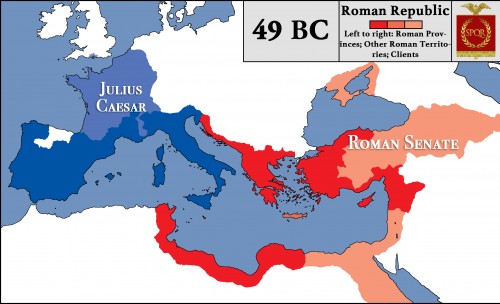
Roman Republic at the Beginning of Caesar's Civil War
Artaxata (now capital after Tigranocerta's demise) was attacked and, although it had resisted a Parthian siege the year before, quickly surrendered. Perhaps Tigranes did not want to see a repeat of the destruction at Tigranocerta and so there may not have been much actual fighting. Tigranes was now in old age and he seems to have bought off Pompey with the vast wealth he had been accumulating over a lifetime. Roman writers record that the Armenian king gave (or was made to give) 6,000 talents of silver to Pompey, 10,000 drachmas to each military tribune, 1000 drachmas for each centurion and 50 for each legionary. In these agreeable circumstances, Tigranes was permitted to retain the heartland of his kingdom trimmed of those territories he had acquired through conquest and with Sophene being given to his traitorous son - who incidentally got his comeuppance when he later insulted Pompey and so was marched to Rome for display in the general's third triumph there.
Armenia was, thus, made into a Roman protectorate but it is debatable if the empire of Tigranes, made up of such disparate and forcibly relocated populations and which was so loosely joined via tribute and coercion without much political apparatus, would have survived very long even without Roman interference. Henceforth, the Armenian state, although officially a friend and ally of the Romans, remained strategically important in the region and so was still a bone of contention between Rome and Parthia (and its successor, Sasanid Persia ). Tigranes continued to rule most of Armenia quietly enough as a vassal state of the Roman Empire, acting as a useful buffer to the Parthians until his death c. 56 BCE aged around 85.
THE FALL OF THE ARTAXIADS
Tigranes was succeeded by his son, Artavasdes II (rc 56 - c. 34 BCE) but the wheels were already coming off the Artaxiad success train. The Roman general Marcus Licinius Crassus obliged Artavasdes to support his disastrous campaign against the Parthians in 53 BCE and then, in 36 BCE, the region was again destabilised when yet another Roman general, this time Mark Antony, passed through, and the Armenians were, once more, asked to provide troops. The Romans were defeated again by their nemesis the Parthians. In 34 BCE Antony turned his attention to Armenia, moved against the Artaxiads and took Artavasdes captive to Alexandria where he would later be executed by Queen Cleopatra. There followed a merry go round of changes in sovereign over the next few decades, first a ruler supported by Rome, then by Parthia until the Artaxiad dynasty fell, replaced by the Arsacid (Arshakuni) dynasty and their founder, Vonon (Vonones), who took the throne c. 12 CE.
Este artículo fue posible gracias al generoso apoyo de la Asociación Nacional de Estudios e Investigación de Armenia y el Fondo de Caballeros de Vartan para Estudios Armenios.
LICENSE
Article based on information obtained from these sources:with permission from the Website Ancient History Encyclopedia
Content is available under License Creative Commons: Attribution-NonCommercial-ShareAlike 3.0 Unported. CC-BY-NC-SA License